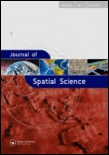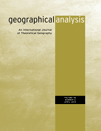
Population Space and Place
Scope & Guideline
Illuminating Spatial Dimensions of Demographic Change
Introduction
Aims and Scopes
- Migration Dynamics:
The journal explores various aspects of migration, including internal and international movements, motivations for migration, and the socio-economic impacts on both sending and receiving communities. - Spatial Analysis:
Utilizing geographical information systems (GIS) and spatial statistical methods, the journal emphasizes the importance of spatial dynamics in understanding population changes and mobility patterns. - Social Integration and Well-being:
Research published in this journal often examines how migration affects individuals' social integration, well-being, and quality of life, particularly for vulnerable populations such as refugees and low-income migrants. - Urban-Rural Interactions:
The journal addresses the complex relationships between urban and rural areas, including patterns of rural gentrification, urban sprawl, and the implications of migration for local economies and communities. - Health and Demography:
A significant focus is placed on the intersection of population health and demographic trends, including how migration influences health outcomes and access to healthcare services. - Policy Implications:
The journal provides insights into the implications of migration and population dynamics for policy-making, emphasizing the need for informed decision-making in urban planning, public health, and social services.
Trending and Emerging
- Impact of COVID-19 on Migration Patterns:
Research exploring how the COVID-19 pandemic has reshaped migration patterns, mobility decisions, and the experiences of migrants is increasingly prominent, emphasizing the pandemic's lasting implications on global and local demographics. - Transnational Lives and Mobility:
There is a growing interest in the complexities of transnational living, including how migrants navigate multiple identities and social networks across borders, reflecting a shift towards understanding migration as a dynamic process. - Social Inequalities and Migration:
Emerging themes focus on the intersection of migration and social inequalities, exploring how factors such as race, gender, and socio-economic status influence migratory experiences and outcomes. - Environmental and Climate Migration:
The journal is increasingly addressing the role of environmental changes and climate-related factors in shaping migration patterns, highlighting the urgency of understanding how these issues affect population dynamics. - Mental Health and Migration:
Research on the mental health implications of migration is gaining attention, particularly concerning the psychological well-being of migrants and the effects of migration on family structures and community ties.
Declining or Waning
- Traditional Demographic Studies:
There is a noticeable decline in papers focusing solely on traditional demographic statistics and analyses, as the field increasingly emphasizes qualitative and mixed-method approaches to understand complex population dynamics. - Longitudinal Studies of Fixed Populations:
Research centered on static population groups or fixed geographic areas is becoming less frequent, with a growing preference for studies that account for fluidity and change in migratory patterns and demographic characteristics. - Homogeneous Migration Narratives:
The journal has seen a reduction in works that present monolithic or overly simplistic narratives of migration, as scholars now prioritize diverse perspectives and the multifaceted experiences of migrants. - Urbanization as a Sole Focus:
Research that solely addresses urbanization without considering the interactions between urban and rural dynamics is waning, as scholars recognize the importance of understanding these interconnections in the context of population movements. - Economic Migration Alone:
The focus on economic migration as the primary driver of population movement is decreasing, with a broader consideration now given to social, cultural, and political factors influencing migration decisions.
Similar Journals

Journal of Spatial Science
Fostering Innovation in Geography and Environmental ScienceThe Journal of Spatial Science, published by Taylor & Francis Ltd, serves as a prominent platform for the dissemination of research in the interdisciplinary fields of geography, atmospheric science, and energy. With an ISSN of 1449-8596 and an E-ISSN of 1836-5655, this journal has established itself as a vital resource since its inception in 2004, boasting an impressive convergence period extending to 2024. Recognized in the Q3 quartile for Atmospheric Science and Energy (miscellaneous), and achieving a Q2 classification in Geography, Planning and Development in 2023, the journal not only reflects the evolving complexities of spatial science but also underscores its increasing relevance in addressing contemporary global challenges. The journal holds a commendable position in Scopus rankings, with notable placements in various categories, further highlighting its academic significance. Researchers, professionals, and students are encouraged to engage with the rich content offered, as the Journal of Spatial Science remains committed to advancing knowledge and fostering discussions pertinent to spatial analysis and its applications.

Geographical Review of Japan-Series B
Illuminating the Socio-Economic Landscapes of JapanGeographical Review of Japan-Series B, an esteemed publication by the Association of Japanese Geographers, serves as a vital platform for scholarly discourse in the field of geography, focusing on the nuanced socio-economic and environmental dynamics of Japan. With the ISSN 1883-4396, this journal aims to publish rigorous, peer-reviewed research that contributes to understanding Japan's geographic phenomena and informing policy-making. Although it is not an open-access journal, it provides insights accessible to researchers, professionals, and students seeking a deeper engagement with regional and international geographical discussions. With its commitment to excellence in academic contribution, the Geographical Review of Japan-Series B remains an essential resource for those dedicated to advancing geographical knowledge in Japan and beyond.

TIJDSCHRIFT VOOR ECONOMISCHE EN SOCIALE GEOGRAFIE
Unveiling Contemporary Socio-Economic ChallengesTIJDSCHRIFT VOOR ECONOMISCHE EN SOCIALE GEOGRAFIE, an esteemed journal published by WILEY, provides a premier platform for the dissemination of cutting-edge research within the fields of economics and social geography. With an ISSN of 0040-747X and an E-ISSN of 1467-9663, this journal has established itself as a pivotal resource, exhibiting a remarkable Q1 ranking in both Economics and Econometrics as well as Geography, Planning and Development for 2023. Notably, it is positioned in the 95th percentile among 821 journals in its category of Social Sciences, and ranks 46th among 716 in Economics and Econometrics, underscoring its influential role in shaping academic discourse. The journal, which has been in publication since 1967 and is anticipated to run through 2024, invites contributions that explore the intricate interplay between economic phenomena and social geospatial dynamics. Researchers, professionals, and students are encouraged to engage with its findings, which are crucial for understanding contemporary socio-economic challenges and innovations on a global scale.

Demografie
Exploring the intricate tapestry of demographic change.Demografie is a distinguished academic journal published by the Cesky Statistical Office in the Czech Republic, serving as a vital platform for scholars and practitioners interested in the multifaceted field of demography. Established in 1976 and consistently contributing until 1999, with a renewed focus from 2014 to 2024, this journal engages with critical issues such as population dynamics, migration patterns, and socio-economic factors influencing demographic changes. For its impactful research contributions, it holds a Q3 category ranking in Demography for 2023, with a Scopus rank of #89 out of 139 in the Social Sciences category, reflecting its credibility and relevance in the field. Although it operates under traditional access, its insightful articles and comprehensive analyses remain valuable resources for researchers, professionals, and students eager to deepen their understanding of demographic trends and policies. The journal's commitment to advancing demographic knowledge makes it an essential read for those navigating the complexities of population studies.

Regional Statistics
Advancing the Dialogue on Regional DevelopmentRegional Statistics, published by the Hungarian Central Statistical Office, is a leading scholarly journal that plays a pivotal role in enhancing the understanding of regional development and statistical analysis. With its ISSN 2063-9538 and E-ISSN 2064-8243, this open-access journal contributes significantly to various fields, including Cultural Studies, Economics, Geography, and Public Administration. The journal has established itself with impressive Scopus rankings, placing it in the top percentiles across multiple categories, evidencing its high-quality research outputs. Covering converged years from 2015 to 2024, Regional Statistics publishes insightful articles that address pressing regional issues, making it an invaluable resource for researchers, professionals, and students alike who are interested in the quantitative dimensions of society. With a reputation bolstered by its Q1 and Q2 categorizations in various disciplines, this journal is not only committed to advancing statistical knowledge but also to fostering interdisciplinary dialogue among statisticians, policymakers, and social scientists.

GEOGRAPHICAL ANALYSIS
Transforming Understanding of Environmental ImpactsGEOGRAPHICAL ANALYSIS, published by WILEY, is a premier scholarly journal that has been at the forefront of geographical and earth-surface research since its inception in 1969. With an ISSN of 0016-7363 and an E-ISSN of 1538-4632, this journal has established itself as an essential resource for researchers and professionals in the fields of Earth-Surface Processes and Geography, Planning and Development, achieving impressive rankings of 13th and 60th in their respective categories according to Scopus, placing it in the Q1 quartile for both. The journal is renowned for its rigorous peer-reviewed articles that contribute valuable insights into spatial analysis, environmental impacts, and urban planning, thus fostering a deeper understanding of geographical phenomena. With access options available through traditional subscriptions, GEOGRAPHICAL ANALYSIS continues to serve as a critical platform for the dissemination of cutting-edge research and innovative methodologies, ultimately shaping the future of geographical inquiry and application.

Espaces-Populations-Societes
Exploring the Dynamics of Space and SocietyEspaces-Populations-Sociétés is a distinguished journal published by UNIV LILLE I SCI & TECH, focusing on the fields of demography and geography. Established in 1983, this open-access journal has committed itself to providing a platform for innovative research and discussions around population dynamics and spatial organization, with accessibility to its content available since 2004. Based in France, at the UFR Géographie & Aménagement, the journal plays a crucial role in advancing understanding of demographic trends and planning developments. With current Scopus rankings highlighting its position in the 25th and 14th percentiles for Demography and Geography, Planning and Development respectively, it maintains a reputable standing within academic circles, establishing its importance in contemporary research landscapes. Researchers, professionals, and students alike will find valuable insights in its comprehensive overview of sociocultural and environmental interactions, as well as place-based issues at the heart of societal development.

Biblio 3W-Barcelona
Empowering researchers in the realm of librarianship.Biblio 3W-Barcelona is a prominent academic journal published by the Universitat de Barcelona, Servei Publicacions, focusing on the dynamic field of library and information science. Established to foster scholarly communication, this journal provides a platform for researchers, professionals, and students dedicated to the advancement of bibliographic studies and library management. Despite lacking a current impact factor, Biblio 3W-Barcelona is recognized for its commitment to high-quality research and its contribution to the field, making it a valuable resource for those engaged in understanding the complexities of information dissemination in modern society. The journal features original research articles, critical reviews, and case studies that invite varied perspectives within the realm of librarianship. Readers can access its comprehensive body of work freely, enriching their knowledge and fostering practical applications in library science. For submission guidelines and further information, visit their website.

GeoScape
Fostering insights into our changing environment.GeoScape is a distinguished open-access journal published by SCIENDO, operating since 2006 and aimed at fostering knowledge in the fields of Ecology, Geography, Urban Studies, and Nature and Landscape Conservation. Based in Warsaw, Poland, the journal maintains a robust academic presence with an impact factor reflective of its quality, prominently positioned in the Q3 category for multiple significant subject areas as of 2023. With its commitment to disseminating high-quality research, GeoScape holds notable Scopus rankings, including a rank of #94 in Urban Studies and #213 in Ecology, signifying its contribution to environmental science discussions. The journal serves as an essential resource for researchers, professionals, and students seeking to advance their understanding of contemporary ecological challenges and urban development in an accessible format.

POPULATION STUDIES-A JOURNAL OF DEMOGRAPHY
Charting the Course of Population Dynamics Since 1947Population Studies: A Journal of Demography is an esteemed scholarly publication dedicated to advancing the understanding of demographic trends and their historical contexts. Published by Routledge Journals, Taylor & Francis Ltd, this journal has a notable impact in its field, recognized as a Q1 category journal in both Demography and History as of 2023. Its Scopus rankings highlight its significance, featuring a remarkable 12th place rank in Arts and Humanities—History and 19th place in Social Sciences—Demography, both underscoring its influential role in academic research. Established in 1947, the journal has consistently contributed to the discourse in population studies, offering a platform for innovative research and critical analysis. While it does not provide open access options, it remains a vital resource for researchers, professionals, and students who seek to explore the complex relationships between population dynamics and historical narratives. Its comprehensive coverage from 1947 to 2024 ensures a rich repository of knowledge, making it essential for anyone involved in demographic research.